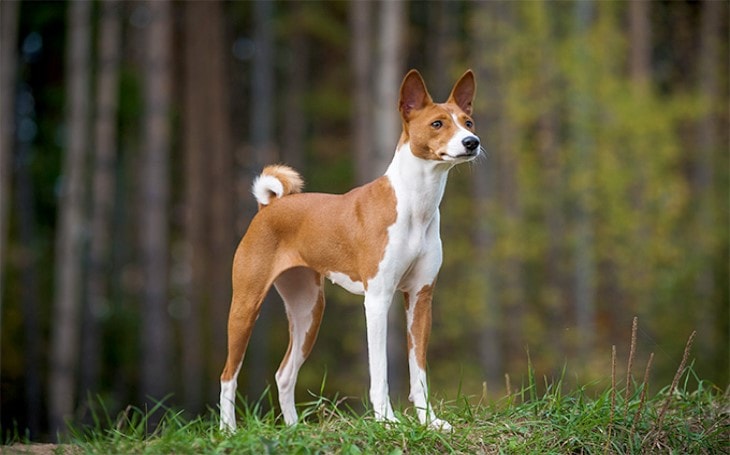Basenji Dog Breed Information
General Information
| Dog Name | Basenji |
|---|---|
| Other Names | Zande Dog |
| Scientific Name | Canis lupus familiaris |
| Breed Type | Sighthound |
| Group | Hound |
| Extinct | No |
| Country of Origin | Congo, Democratic Republic of the |
Physical And Size
| Min Life Span | 13 |
|---|---|
| Max Life Span | 11 |
| Min Ideal Weight for male | 9 |
| Max Ideal Weight for male | 12 |
| Min Ideal Weight for female | 9 |
| Max Ideal Weight for male | 12 |
Ranking
| Intelligent Rank | |
|---|---|
| Trainability | |
| Playfulness | |
| Affection Level | |
| Social Needs | |
| Barking | |
| Watchdog Ability | |
| Territorial | |
| Mouthiness | |
| Adaptability |
Characterisitics
| Temperament | Smart, Quiet, Independent |
|---|---|
| Prey Drive | Yes |
| Fighting Dog | No |
Friendliness
| Stranger Friendly | High |
|---|---|
| Child Friendly | High |
| Cat Friendly | Medium |
| Apartment Friendly | High |
| Senior Citizens Friendly | High |
| Service Dog | High |
| Search and Rescue Dog | High |
| Biting Potential | Medium |
| Country of Origin | Democratic Republic of the Congo |
| Nicknames and Other Names | Zande Dog, Ando Angari, Congo Dog, African Barless Dog, African Bush Dog |
| Scientific Name | Canis lupus familiaris |
| Breed Type | Sighthound |
| Group | Hound |
| Bred For | To trap the game on hunter’s nets, carry goods and alert the owner of threat |
| Size | Medium-sized |
| Recognized By | FCI, CKC, AKC, NZKC, ANKC, KC (UK), UKC |
| Life Span | 13-14 years |
| Ideal Weight | Male: 24 pounds Female: 22 pounds |
| Ideal Height | Male: 17 inches Female: 16 inches |
| Fur Type | Short and smooth |
| Common Colors | Red & White, Black & White, Brindle & White, Black Tan & White |
| Markings | Brindle Markings |
| Availability | Rare |
| Achievements | UKC Best of Breed Winner |
| Suitable for Apartments | No |
| Used in World War | No |
| Most Similar To | Ibizan Hound |
The Basenji, Africa’s Barkless dog was originally found in Congo. He uses both scent and slight to hunt. They are unique and charming pets best for owners who can meet their daily exercises and the challenge of training this canine.
Basenji are small sized dogs who stands 16-17 inches from the shoulder. They are known for their shiny short coat, with wrinkled forehead and expressive almond shaped eyes and tightly curled tail.
Origin Of Basenji
Basenji is one of the oldest breeds of dogs and perhaps that’s why it is not a barker. Unlike his cousin wolf, he can bark but usually barks only once and
Basenji was discovered in the 19th by the Westerns in the Congo region in Africa. There they were bred to flush games on nets, to carry goods and to warn when approach of the dangerous animals.
In early times a good hunter Basenji was valued more than a wife by some tribes in Africa.
The first efforts to bring the Basenji to Europe failed because the imported dogs all died of diseases shortly after arrival. The import of this breed was first successful in 1930 both in England and the United States.
“The Basenji Club Of America” was formed a year before
Are They Child Friendly?
Basenjis are friendly and affectionate but they have a dominant temperament so they thinks that small children are below their pecking order. Sometimes small children can do things like pull their tails, jumping around them and make noise which may make Basenjis pretty aggressive.
The owner needs to supervise the
Behavior ,Temperament & Personality
Basenji is willful and dominant, so to own a Basenji you need to be courageous and confident. Though Basenji’s don’t bark, they can howl like a wolf and this is by no means a silent breed.
Basenji’s are loving and affectionate towards their family but not to strangers. They tend to form a bond with their family and dislike if left alone. So, when leaving a Basenji alone, problem solving toys and a lot of bones need to be left around them for their entertainment.
Basenji breeders and owners often refer them as ‘ catlike’ as they are great in licking to groom and are quite. Along with this they seem to like climbing up onto high paces.
Trainabilty
Basenji’s are known to be clever dogs, but not easy to train. Patience and confidence are needed when dealing with a Basenji.
Like other hounds, the Basenji is intelligent and independent and take time to decide whether to follow a command. Breeders recommend that training and socialization should be done as early as possible. There are chances of wary and lack of trust in people if not properly trained.
Facts
Interesting facts about Basenji are:
- Basenji’s don’t bark.
- Basenji groom themselves.
- They don’t like night walks.
- The Basenji was a Royal Gift
- They have no body odor.
Health Issues
| General Health | Healthy | |
| Common Health Issues | Fanconi Syndrome, Patellar Luxation, Hip Dysplasia, Bloat, Cataracts | |
| Hypoallergenic | No | |
| Vaccination Required | Rabies, Canine Distemper, Canine Parvovirus, Leptospirosis, Canine Parainfluenza, Kennel Cough, Canine Coronavirus | |
| Shedding | None to low | |
| Drooling | Low | |
| Grooming | Easy and Minimal grooming | |
| Weight Gain Potential | Low to Average | |
| Separation Anxiety | Low Chance | |
| Allergies | None | |
| Diets and Supplements | Protein- 20% Fat-10% Omega-3 fatty acid |
The Basenji, which has an average life span of 12 to 14 years suffers from some common health issues , such as:
- Fanconi Syndrome – Fanconi Syndrome is a kidney or renal problem which is very much common in Basenjis. This is a hereditary disorder where the renal tube is unable to reabsorb nutrients and electrolytes.
- Hip dysplasia (CHD),
- Corneal dystrophy, and
- Patellar luxation.
Color
Basenji’s comes in four colors, They are –
- Red
- Black
- Black and Tan
- Brindle.
Price of Basenji pup
The average cost of a Basenji is $800.

Image Via Gumtree
Which Dogs Similar To Basenji?
Dog breed similar to Basenji are:
- Pharaoh Hound
- Azawakh
- Boerboel
- Ibizan Hound
- Rhodesian Ridgeback
- Basenji Mix Dog Breed
Visit Doglime For More Dog breed Information.
Tags











One thought on “Basenji Dog Breed Information”